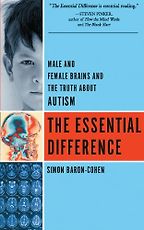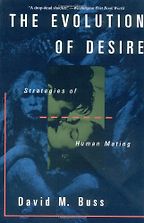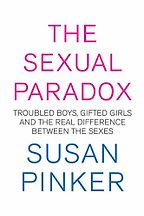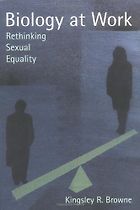Your first book is The Essential Difference by Simon Baron-Cohen. Why have you chosen this one?
Baron-Cohen’s book is one of the best popular books on the evolved sex differences in the brain. It explains how and why men’s and women’s brains have their distinct strengths and weaknesses. Men’s need to invent, manufacture, and improve tools and weapons throughout evolutionary history has made the male brain particularly strong on systemising (logically and rationally dealing with things), whereas women’s need to leave their natal group upon puberty and marry into a neighbouring group full of strangers has made the female brain particularly strong on empathising (relating to other people). Women’s need to take care of infants, by anticipating their needs when they cannot yet speak, also makes them better able to read others’ minds. At the same time, ancestral men’s need to engage in solitary hunting and to wage wars against enemies has made their brains particularly low on empathising. It is easier to be alone or brutally murder others if you don’t feel for people very well.
Men’s higher average ability for systemising explains why they excel at occupations such as science and engineering, while women’s higher average ability for empathising explains why they are more social and why they are better judges of character. However, when men’s (and, very occasionally, women’s) brains are too systemising and too little empathising, they can exhibit symptoms of autism or Asperger’s syndrome. Baron-Cohen is a world-renowned autism researcher at the University of Cambridge, and his extreme male brain theory of autism makes a lot of sense.
So he thinks these differences are inherent in brain structure, does he?
Through a series of very ingenious experiments, Baron-Cohen and his collaborators convincingly demonstrate that these sex differences in the brain are innate, not learned through socialisation. In one of the experiments, they use babies who are less than 24 hours old, and yet boys still prefer mechanical objects while girls still prefer human faces. It would be very difficult to argue that anything that emerges within 24 hours of birth is not innate and evolutionarily designed. Other researchers have shown that children’s toy preference may also be largely innate, because males and females of other species show the same preference. Male monkeys still prefer the cars and balls that human boys prefer, and female monkeys still prefer the dolls and cooking pots that human girls prefer. Since monkeys are not socialised by human parents, and they have not even seen these stereotypically masculine and feminine toys before the experiment, it’s difficult to argue that their preferences for “sex-appropriate” toys are learned. Preponderance of scientific evidence shows that men and women have entirely different brains, and such differences are evolutionarily designed and therefore innate.
Tell me about the David Buss book, The Evolution of Desire: Strategies of Human Mating.
Buss’s book approaches the evolved sex differences in the brain slightly differently. In the 1980s, David M Buss, one of the Deans of Modern Evolutionary Psychology, conducted a worldwide survey of more than 10,000 people from 37 different cultures. He and his collaborators simply asked men and women throughout the world what qualities they sought in their ideal mate. They discovered that, regardless of their race, religion, history, culture, and geographic location, men and women everywhere sought very similar qualities in their mates. While there are some qualities – such as intelligence and kindness – that both men and women wanted in their mates, there were very marked sex differences. Men sought youth and physical attractiveness in their mates, whereas women sought resources and status in theirs.
Five Books interviews are expensive to produce. If you're enjoying this interview, please support us by donating a small amount.
Of course, we don’t need evolutionary psychology to know what men and women want in their mates. Our great-grandmothers (and their great-grandmothers) always knew that men liked young beautiful women, and women liked rich and powerful men, without any knowledge of evolutionary psychology. Evolutionary psychology is noteworthy, not in what they discovered, but in explaining why. Both youth and physical attractiveness are markers of health and fecundity, so young and beautiful women on average make better mothers. Because of men’s need to protect and invest heavily in their children, resourceful men of higher status make better fathers. What men and women seek in their ideal mates is dictated by their evolutionary needs. They are driven by evolutionary logic that they themselves are largely oblivious to. Buss’s book explains the evolutionary logic behind what men and women desire in their mates and why.
Your next book takes men and women to the workplace. Biology at Work: Rethinking Sexual Equality by Kingsley Browne
Browne’s book demonstrates how these evolved sex differences in the brain (which Baron-Cohen and Buss talk about) manifest themselves in the workplace. Traditional social scientists (like economists and sociologists) have assumed that men and women are on the whole identical, and therefore any widespread and systematic differences in economic and social outcomes must reflect “discrimination” and other external factors. Browne argues that this is not necessarily the case, because men and women are biologically different in their preferences, temperaments, and abilities.
Baron-Cohen’s book shows that male and female brains are different, and men are on average better at systemising and women on average are better at empathising. Thus “occupational sex segregation”, where men and women tend to have different occupations, is a reflection of what men and women want to do and are good at doing. This is why men far outnumber women in such systemising occupations as science and engineering, and women far outnumber men in such empathising occupations as nursing and teaching.
Buss’s book shows the importance of resources and status for male mate value; it is important for men to accumulate resources and attain high status because women prefer to mate with resourceful men of high status. It is far less important for women to do so because men are mostly attracted to young, beautiful women, not rich, powerful women. Browne’s book conclusively demonstrates that men on the whole make more money and attain higher status than women, not because of “employer discrimination” or any other external factors, but simply because men want to make more money and women have better things to do than make money. In other words, occupational sex segregation and sex gap in pay exist mostly because men and women are free to pursue what they want. Complete “equality” that feminists want can only come about in a totalitarian society where men and women lose all their liberties and freedoms.
Very contentious stuff. On to Susan Pinker, The Sexual Paradox: Troubled Boys, Gifted Girls and the Real Difference Between the Sexes.
Pinker pursues the same issue as Browne does, but from a slightly different perspective. While the legal scholar Kingsley R Browne advances his argument with court cases, legal precedents, and government statistics, the clinical psychologist Susan Pinker weaves her tales with client case studies, personal experiences and vivid anecdotes.
Pinker returns to Baron-Cohen’s theme of the evolved sex difference in male and female brains. Men’s greater tendency toward systemising, when expressed in extreme form, can render them clinically suffering from autism, Asperger’s syndrome and other disabilities that hinder their abilities to communicate with and relate to others. Pinker points out that boys and men are in general far more fragile and suffer from a far greater number of illnesses, conditions, and syndromes than women do. Men, not women, are the weaker sex.
What’s interesting about the tales that Pinker tells in her book is that, despite these disabilities and clinical conditions, many of the men who suffer from them nonetheless manage to pursue successful careers, by working around and sometimes even taking advantage of their disabilities. In sharp contrast, Pinker also tells tales of gifted, intelligent women with promising careers, who nonetheless drop out of the rat race to spend more time with their families. Pinker’s book puts names, personal anecdotes and intimate stories behind the court cases and statistics that Browne discusses in his book, and demonstrates that women indeed do have much better things to do than make money. They’re called life.
Your last book is Genes, Girls, and Gamow: After The Double Helix.
I wanted to include at least one book written by my hero, James D Watson. Humans, just like all other species in nature, are largely unaware of the evolutionary logic behind their design. They know what they want, but they don’t usually know why they want what they want. The ultimate (albeit largely unconscious) goal of all human behaviour (as well as the behaviour of all other species) is reproductive success. We do what we do, ultimately, to make as many copies of our genes as possible. In particular, virtually everything men do has the ultimate goal of impressing women, so that, hopefully, some of them would agree to have sex with them and have their children. Men do everything they do in order to get laid.
In my 2003 article in The Journal of Research in Personality, I show that scientists are no exception to this rule; they also do what they do in order to impress women. Just like criminals, male scientists appear to do their best work when they are young and single, and seem to “desist” from doing good science once they are married (just like male criminals do). The 1962 Nobel Laureate James D Watson is exceptional in this regard, because he seems to be fully conscious of the evolutionary logic behind his motives to do great science.
In Genes, Girls, and Gamow, Watson’s second autobiography (after The Double Helix and before Avoid Boring People), Watson chronicles his days as a young assistant professor at Caltech and Harvard, after his discovery (with Francis Crick) of the structure of the DNA and before his marriage to his wife Liz. Even though the book ends when Watson marries Liz, it’s not mostly about Liz, but another woman Watson pursued during this time, the daughter of the great Harvard biologist Ernst Mayr, Christa.
Somehow this is all quite depressing. Given that men and women are so different and so promiscuous, is it possible for any man to genuinely be compatible with any woman for a whole lifetime?
Be compatible with or understand each other? Given how different men and women are, it might be very difficult for men and women to understand each other truly, deeply and completely, but I don’t think it means that they could not be compatible partners for life. After all, the same process that made them very different – evolution – also made them very compatible; men and women have evolved together and with each other for millions of years. I think the first key to a successful long-term relationship as compatible partners may be to realise that men and women cannot truly understand each other because they are so completely different. But why can’t different people be compatible with each other? The compatibility can stem from complementarity, not the sameness.
Is there any research that shows how we can find our ideal partner?
In 1966, a couple of statisticians mathematically proved that the optimal method of finding an ideal mate is to reject the first 37 per cent of all the lifetime potential mates, and then marry the first candidate who is better than all the ones who came before. If you consistently follow this method, you have about 37 per cent chance of marrying the best of all possible candidates. You may think that 37 per cent chance is not very good, but, unfortunately, there are no other methods that will consistently produce a higher rate of success. Given that this method is mathematically proven to be optimal, it is likely that evolution has equipped women to follow this strategy, without being consciously aware of the mathematics behind it. Among other things, this can explain why women in large metropolises stay single longer and marry later than women in small towns, because the former have more men to reject than the latter before they can get serious about finding a husband.
Get the weekly Five Books newsletter
Is there any hope in the mating game for women who are not young or beautiful and men who are not rich or successful?
Of course! The socially imposed monogamy (we are legally required to be monogamous even though we are by nature polygynous) means that there is someone for everyone. There is a man for every woman and a woman for every man. There would have to be, given the roughly 50-50 sex ratio and the socially imposed monogamy. The process of assortative mating means that the most desirable (young and beautiful) women pair off with the most desirable (rich and powerful) men, less desirable women pair off with less desirable men, and the least desirable women pair off with the least desirable men. However, evolution has equipped us with the capacity to fall truly in love, not necessarily with the most desirable potential mate, but with someone who would make a good match for us in the process of assortative mating. Most women truly love their husbands despite the fact that George Clooney is out there (and single), and most men truly love their wives despite the fact that Keira Knightley is out there (and single). If we are designed to pursue only the most desirable mate seriously and earnestly, then every woman except for one (the lucky eventual Mrs George Clooney) and every man except for one (the lucky eventual Mr Keira Knightley) will remain unmarried for life. Evolution and our genes are much smarter than that.
Five Books aims to keep its book recommendations and interviews up to date. If you are the interviewee and would like to update your choice of books (or even just what you say about them) please email us at [email protected]










